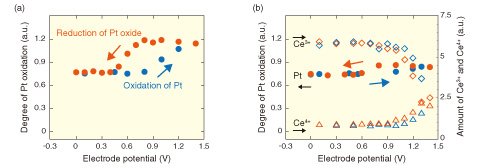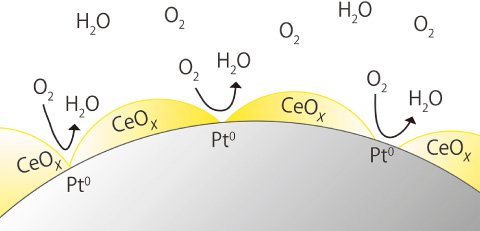
Fig.5-17 Oxidation status of Pt and Ce

Fig.5-18 Schematic illustration of oxygen reduction reaction at the surface of the Pt-CeOx nanocomposite
The polymer electrolyte fuel cell (PEFC) is a clean and compact power generation system that can perform below 100 °C, can be miniaturized easily, and emits only water as exhaust. These features enable integration of the PEFC into automobiles and mobile electronic devices. On the other hand, the PEFC demands a large amount of an expensive precious metal (platinum, Pt), which limits its wide adoption. In the last decades, many studies for reducing the amount of Pt in PEFCs have been carried out. For example, high-performance electrode materials with efficiencies close to the theoretical value have been explored.
The Global Research Center for Environment and Energy based on Nanomaterials Science (GREEN) at the National Institute for Materials Science (NIMS) investigated the nanocomposite catalyst Pt-CeOx, which exhibits higher oxygen reduction reaction (ORR) activity than the conventional Pt catalyst, and established its synthetic method. A joint research group comprising researchers from GREEN and JAEA investigated the role of cerium oxide in the Pt-CeOx catalyst and elucidated the mechanism by which the ORR activity on the catalyst is enhanced.
To elucidate the valence of platinum and/or cerium atoms in the Pt-CeOx catalyst and the conventional Pt catalyst under ORR, in situ X-ray absorption fine structure measurements were carried out at SPring-8. The results revealed that on the conventional Pt catalyst, a surface oxide began to form at the potential at which ORR starts to occur. However, on the Pt-CeOx catalyst, Pt oxide formation was suppressed, but Ce3+ was oxidized to Ce4+ at the potential at which Pt is oxidized (Fig.5-17). These results suggest that on the Pt-CeOx catalyst, charge transfer at the Pt/Ce interface occurs, and Ce3+ in the Ce oxide is oxidized instead of Pt (Fig.5-18). Previous studies reported that the Pt surface oxide reduces the ORR activity. Finally, it is concluded that the Pt-CeOx catalyst exhibits intrinsic high ORR activity due to the suppression of Pt oxide formation.